Topography–Land Surface Temperature Coupling: A Promising Approach for the Early Identification of Coal Seam Fire Zones
Abstract
1. Introduction
2. Materials and Methods
2.1. Study Area
2.2. Datasets
2.2.1. DEM
2.2.2. Landsat-9
2.3. Topographical and Temperature Indexes
2.3.1. Topographical Indexes
2.3.2. Temperature Indexes
2.3.3. Threshold-Based LSTA Recognition Method
2.4. Statistical Analysis
3. Results
3.1. Topographical Indexes of the Study Area
3.2. Temperature Indexes of the Study Area
3.3. Depth-Dependent Differences in Topography and Temperature Indexes
3.4. Correlation and Linear Regression Analysis of Topography and Temperature Indexes
4. Discussion
4.1. Application of the Threshold-Based LSTA Recognition Method
4.2. Effects of Topography on the Distribution of LSTA
5. Conclusions
Author Contributions
Funding
Data Availability Statement
Acknowledgments
Conflicts of Interest
References
- Liu, Y.; Heng, W.; Yue, H. Quantifying the coal mining impact on the ecological environment of Gobi open-pit mines. Sci. Total Environ. 2023, 883, 163723. [Google Scholar] [CrossRef] [PubMed]
- Liang, Y. Progress and Advancements of coal mine gas control and management for Safe Mining in China. J. Ind. Saf. 2024, 1, 100005. [Google Scholar] [CrossRef]
- Ge, W.; Li, J.; Liu, J.; Xu, C.; Wu, H.; Zhou, Y.; Ren, Y.; Wang, X.; Zheng, L.; Zhou, J.; et al. Impacts of coal use phase-out in China on the atmospheric environment: (1) emissions, surface concentrations and exceedance of air quality standards. Atmos. Environ. 2023, 315, 120163. [Google Scholar] [CrossRef]
- Zhang, Y.; Wang, Y.; Huo, W.; Zhao, F.; Hu, Z.; Wang, T.; Song, R.; Liu, J.; Zhang, L.; Fernández, J.; et al. Ground Deformation Monitoring over Xinjiang Coal Fire Area by an Adaptive ERA5-Corrected Stacking-InSAR Method. Remote Sens. 2023, 15, 1444. [Google Scholar] [CrossRef]
- Kuenzer, C.; Zhang, J.; Sun, Y.; Jia, Y.; Dech, S. Coal fires revisited: The Wuda coal field in the aftermath of extensive coal fire research and accelerating extinguishing activities. Int. J. Coal Geol. 2012, 102, 75–86. [Google Scholar] [CrossRef]
- Pandey, J.; Kumar, D.; Panigrahi, D.C.; Singh, V.K. Temporal transition analysis of coal mine fire of Jharia coalfield, India, using Landsat satellite imageries. Environ. Earth Sci. 2017, 76, 439. [Google Scholar] [CrossRef]
- Stracher, G.B. Coal fires burning around the world: A Global Catastrophe. Int. J. Coal Geol. 2004, 59, 1–6. [Google Scholar] [CrossRef]
- Zhou, B.; Wu, J.; Wang, J.; Wu, Y. Surface-based radon detection to identify spontaneous combustion areas in small abandoned coal mine gobs: Case study of a small coal mine in China. Process Saf. Environ. Prot. 2018, 119, 223–232. [Google Scholar] [CrossRef]
- Syed, T.H.; Riyas, M.J.; Kuenzer, C. Remote sensing of coal fires in India: A review. Earth-Sci. Rev. 2018, 187, 338–355. [Google Scholar] [CrossRef]
- Wang, T.; Wang, Y.; Zhao, F.; Feng, H.; Liu, J.; Zhang, L.; Zhang, N.; Yuan, G.; Wang, D. A spatio-temporal temperature-based thresholding algorithm for underground coal fire detection with satellite thermal infrared and radar remote sensing. Int. J. Appl. Earth Obs. Geoinf. 2022, 110, 102805. [Google Scholar] [CrossRef]
- Huo, H.; Ni, Z.; Gao, C.; Zhao, E.; Zhang, Y.; Lian, Y.; Zhang, H.; Zhang, S.; Jiang, X.; Song, X.; et al. A Study of Coal Fire Propagation with Remotely Sensed Thermal Infrared Data. Remote Sens. 2015, 7, 3088–3113. [Google Scholar] [CrossRef]
- Song, Z.; Kuenzer, C.; Zhu, H.; Zhang, Z.; Jia, Y.; Sun, Y.; Zhang, J. Analysis of coal fire dynamics in the Wuda syncline impacted by fire-fighting activities based on in-situ observations and Landsat-8 remote sensing data. Int. J. Coal Geol. 2015, 141–142, 91–102. [Google Scholar] [CrossRef]
- Liu, Y.; Qi, X.; Luo, D.; Zhang, Y.; Qin, J. Detection and management of coal seam outcrop fire in China: A case study. Sci. Rep. 2024, 14, 4609. [Google Scholar] [CrossRef]
- Huo, H.; Jiang, X.; Song, X.; Li, Z.-L.; Ni, Z.; Gao, C. Detection of Coal Fire Dynamics and Propagation Direction from Multi-Temporal Nighttime Landsat SWIR and TIR Data: A Case Study on the Rujigou Coalfield, Northwest (NW) China. Remote Sens. 2014, 6, 1234–1259. [Google Scholar] [CrossRef]
- Mansor, S.B.; Cracknell, A.P.; Shilin, B.V.; Gornyi, V.I. Monitoring of underground coal fires using thermal infrared data. Int. J. Remote Sens. 1994, 15, 1675–1685. [Google Scholar] [CrossRef]
- Guo, J.; He, T.; Xiao, W.; Lei, K. Time series procession for monitoring land disturbance caused by surface coal mining in China. J. Clean. Prod. 2024, 448, 141585. [Google Scholar] [CrossRef]
- Xie, J.; Xue, S.; Cheng, W.; Wang, G. Early detection of spontaneous combustion of coal in underground coal mines with development of an ethylene enriching system. Int. J. Coal Geol. 2011, 85, 123–127. [Google Scholar] [CrossRef]
- Singh, A.K.; Singh, R.V.K.; Singh, M.P.; Chandra, H.; Shukla, N.K. Mine fire gas indices and their application to Indian underground coal mine fires. Int. J. Coal Geol. 2007, 69, 192–204. [Google Scholar] [CrossRef]
- Stracher, G.B.; Prakash, A.; Schroeder, P.; Mccormack, J.; Zhang, X.; Dijk, P.V.; Blake, D. New mineral occurrences and mineralization processes: Wuda coal-fire gas vents of Inner Mongolia. Am. Mineral. 2005, 90, 1729–1739. [Google Scholar] [CrossRef]
- Biswal, S.S.; Gorai, A.K. Change detection analysis in coverage area of coal fire from 2009 to 2019 in Jharia Coalfield using remote sensing data. Int. J. Remote Sens. 2020, 41, 9545–9564. [Google Scholar] [CrossRef]
- Gao, Y.; Hao, M.; Wang, Y.; Dang, L.; Guo, Y. Multi-Scale Coal Fire Detection Based on an Improved Active Contour Model from Landsat-8 Satellite and UAV Images. ISPRS Int. J. Geo-Inf. 2021, 10, 449. [Google Scholar] [CrossRef]
- Yu, B.; She, J.; Liu, G.; Ma, D.; Zhang, R.; Zhou, Z.; Zhang, B. Coal fire identification and state assessment by integrating multitemporal thermal infrared and InSAR remote sensing data: A case study of Midong District, Urumqi, China. ISPRS J. Photogramm. Remote Sens. 2022, 190, 144–164. [Google Scholar] [CrossRef]
- Song, D.; Hu, Z.; Zeng, J.; Sun, H. Influence of mining on vegetation in semi-arid areas of western China based on the coupling of above ground and below ground—A case study of Daliuta coalfield. Ecol. Indic. 2024, 161, 111964. [Google Scholar] [CrossRef]
- Meng, Z.; Shi, X.; Li, G. Deformation, failure and permeability of coal-bearing strata during longwall mining. Eng. Geol. 2016, 208, 69–80. [Google Scholar] [CrossRef]
- Conrad, O.; Bechtel, B.; Bock, M.; Dietrich, H.; Fischer, E.; Gerlitz, L.; Wehberg, J.; Wichmann, V.; Bohner, J. System for Automated Geoscientific Analyses (SAGA) v. 2.1.4. Geosci. Model Dev. 2015, 8, 1991–2007. [Google Scholar] [CrossRef]
- Moore, I.D.; Grayson, R.B.; Ladson, A.R. Digital terrain modelling: A review of hydrological, geomorphological, and biological applications. Hydrol. Process. 1991, 5, 3–30. [Google Scholar] [CrossRef]
- O’Loughlin, E.M. Prediction of Surface Saturation Zones in Natural Catchments by Topographic Analysis. Water Resour. Res. 1986, 22, 794–804. [Google Scholar] [CrossRef]
- Beven, K.J.; Kirkby, M.J. A physically based, variable contributing area model of basin hydrology / Un modèle à base physique de zone d’appel variable de l’hydrologie du bassin versant. Hydrol. Sci. Bull. 1979, 24, 43–69. [Google Scholar] [CrossRef]
- Seibert, J.; Stendahl, J.; Sorensen, R. Topographical influences on soil properties in boreal forests. Geoderma 2007, 141, 139–148. [Google Scholar] [CrossRef]
- Barsi, J.A.; Barker, J.L.; Schott, J.R. An Atmospheric Correction Parameter Calculator for a single thermal band earth-sensing instrument. In Proceedings of the IGARSS 2003. 2003 IEEE International Geoscience and Remote Sensing Symposium. Proceedings (IEEE Cat. No.03CH37477), Toulouse, France, 21–25 July 2003; Volume 3015, pp. 3014–3016. [Google Scholar]
- Barsi, J.; Schott, J.; Palluconi, F.; Hook, S. Validation of a Web-Based Atmospheric Correction Tool for Single Thermal Band Instruments; SPIE: Washington, DC, USA, 2005; Volume 5882. [Google Scholar]
- Bauer, D.F. Constructing confidence sets using rank statistics. J. Am. Stat. Assoc. 1972, 67, 687–690. [Google Scholar] [CrossRef]
- Hollander, M.; Wolfe, D.A. Nonparametric Statistical Methods, 2nd ed.; John Wiley & Sons: New York, NY, USA, 1999. [Google Scholar]
- R Core Team. R: A Language and Environment for Statistical Computing; R Foundation for Statistical Computing: Vienna, Austria, 2019. [Google Scholar]
- RStudio Team. RStudio: Integrated Development Environment for R, RStudio Team: Boston, MA, USA, 2019.
- Kuenzer, C.; Stracher, G.B. Geomorphology of coal seam fires. Geomorphology 2012, 138, 209–222. [Google Scholar] [CrossRef]
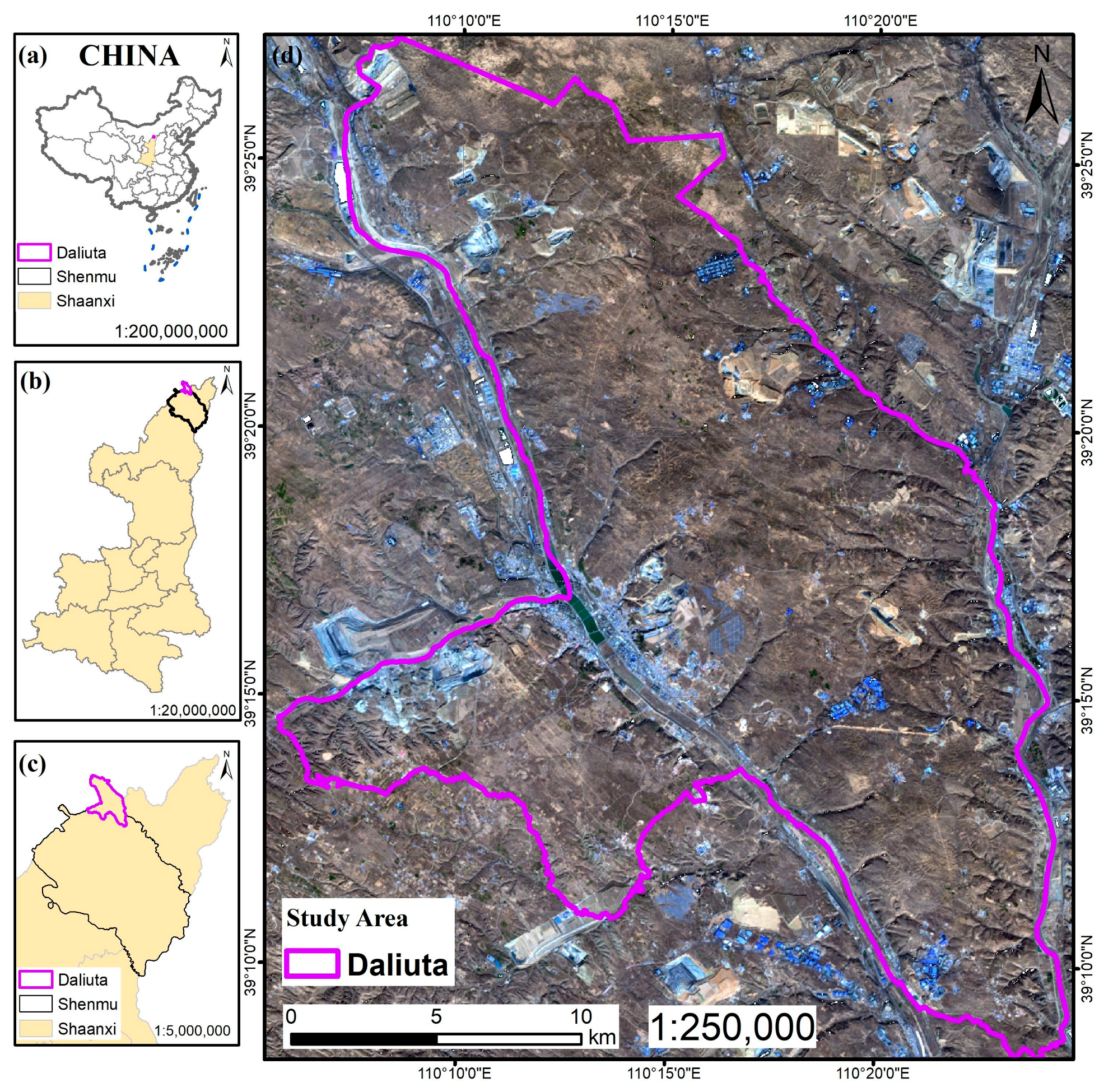
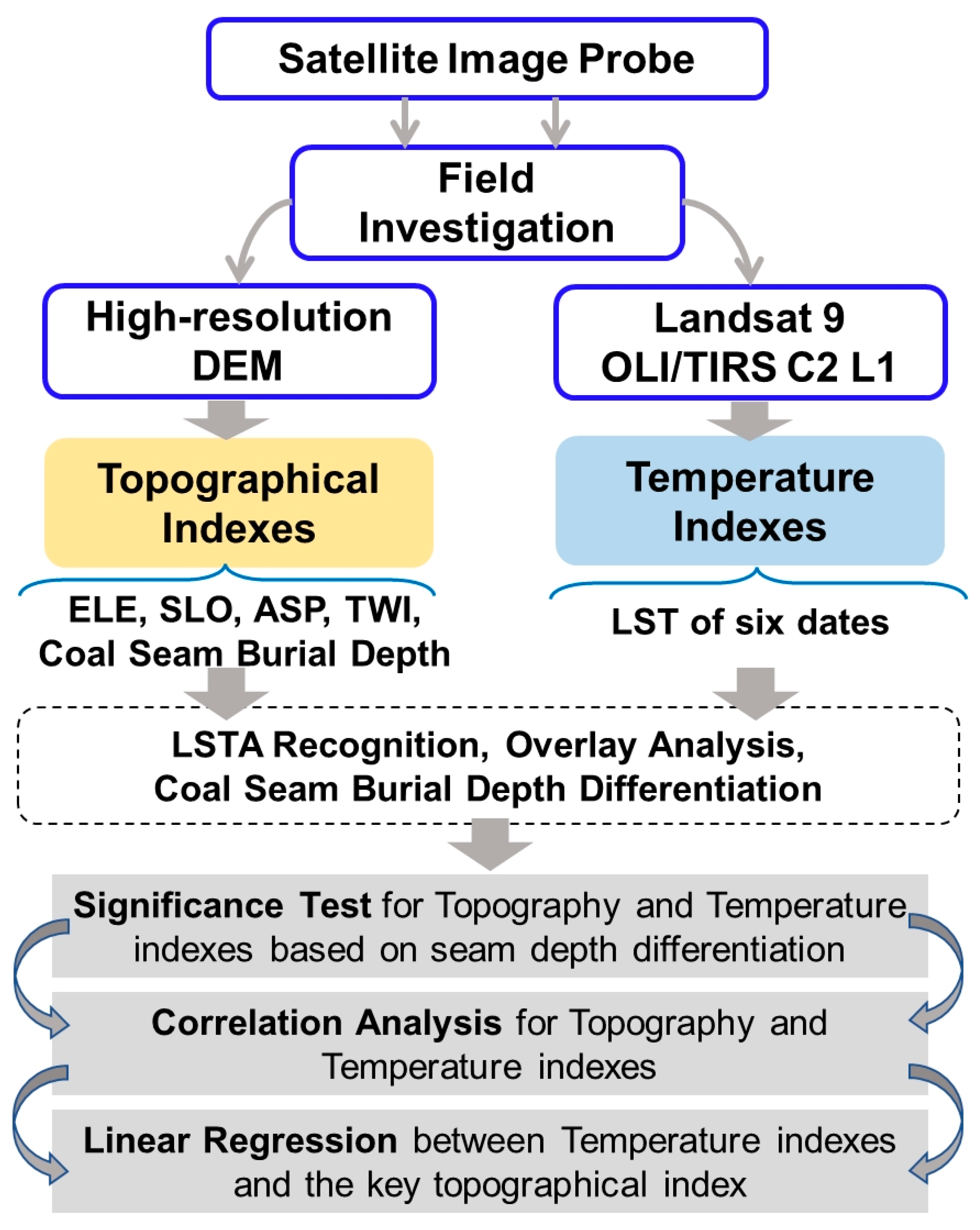
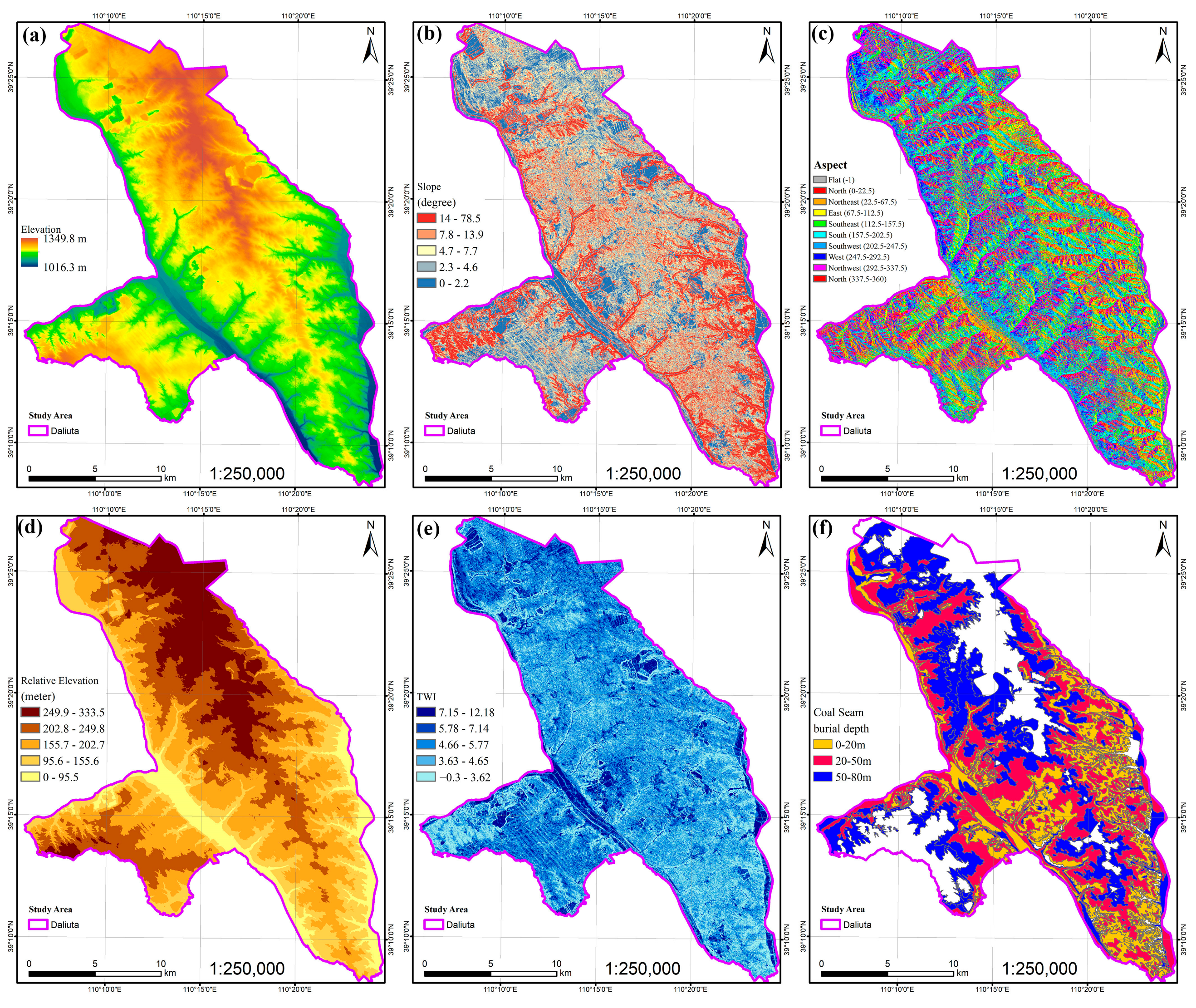
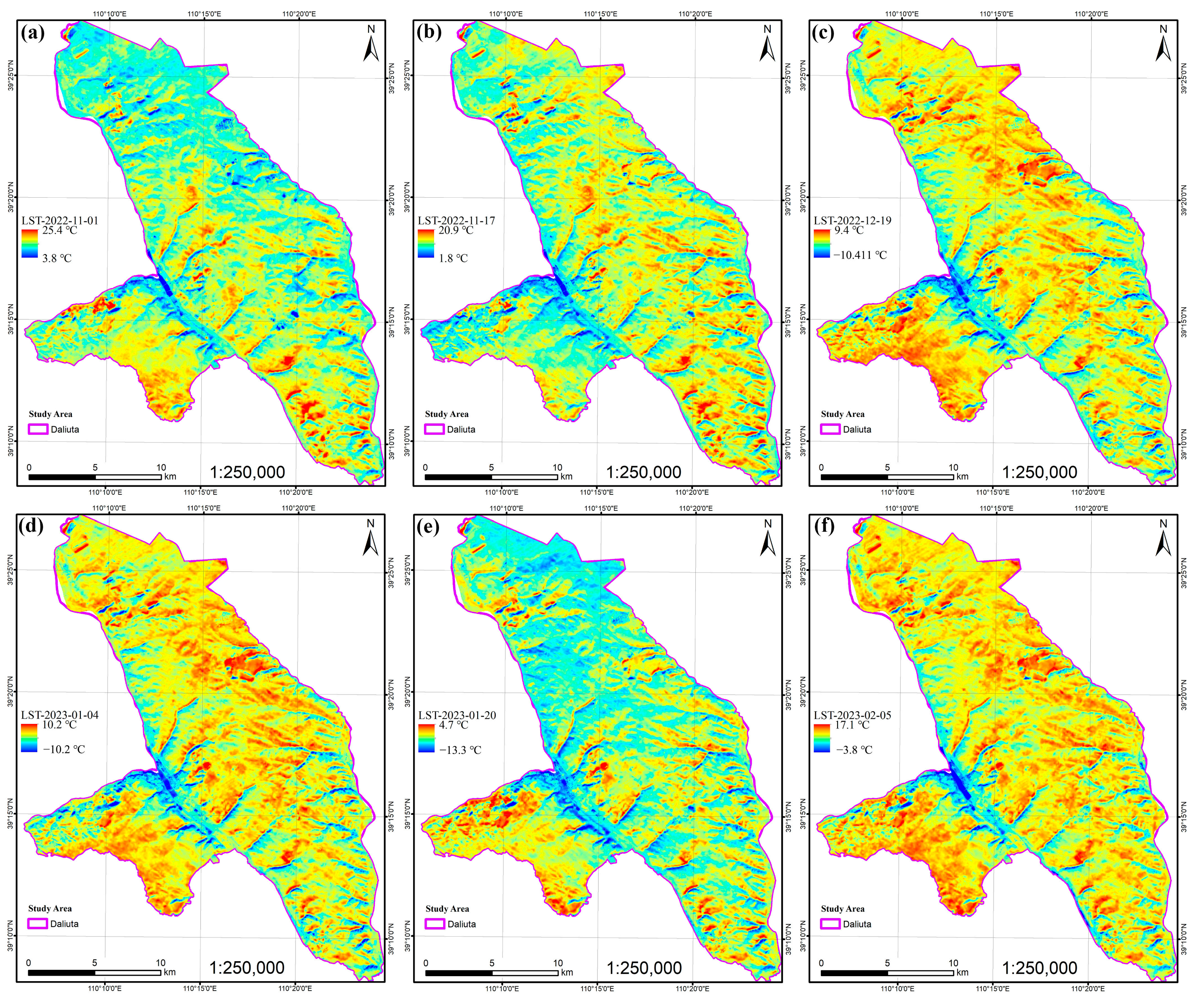
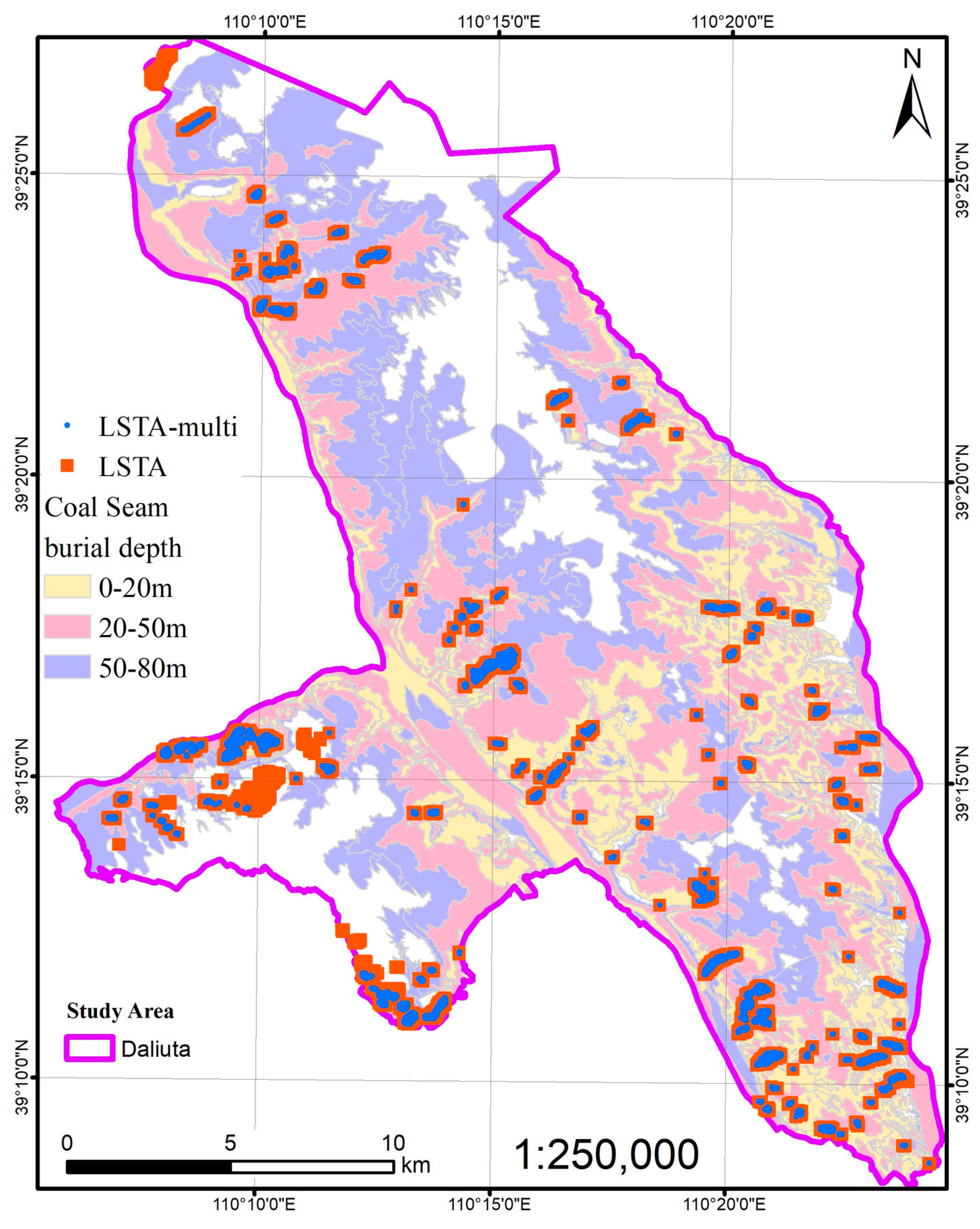
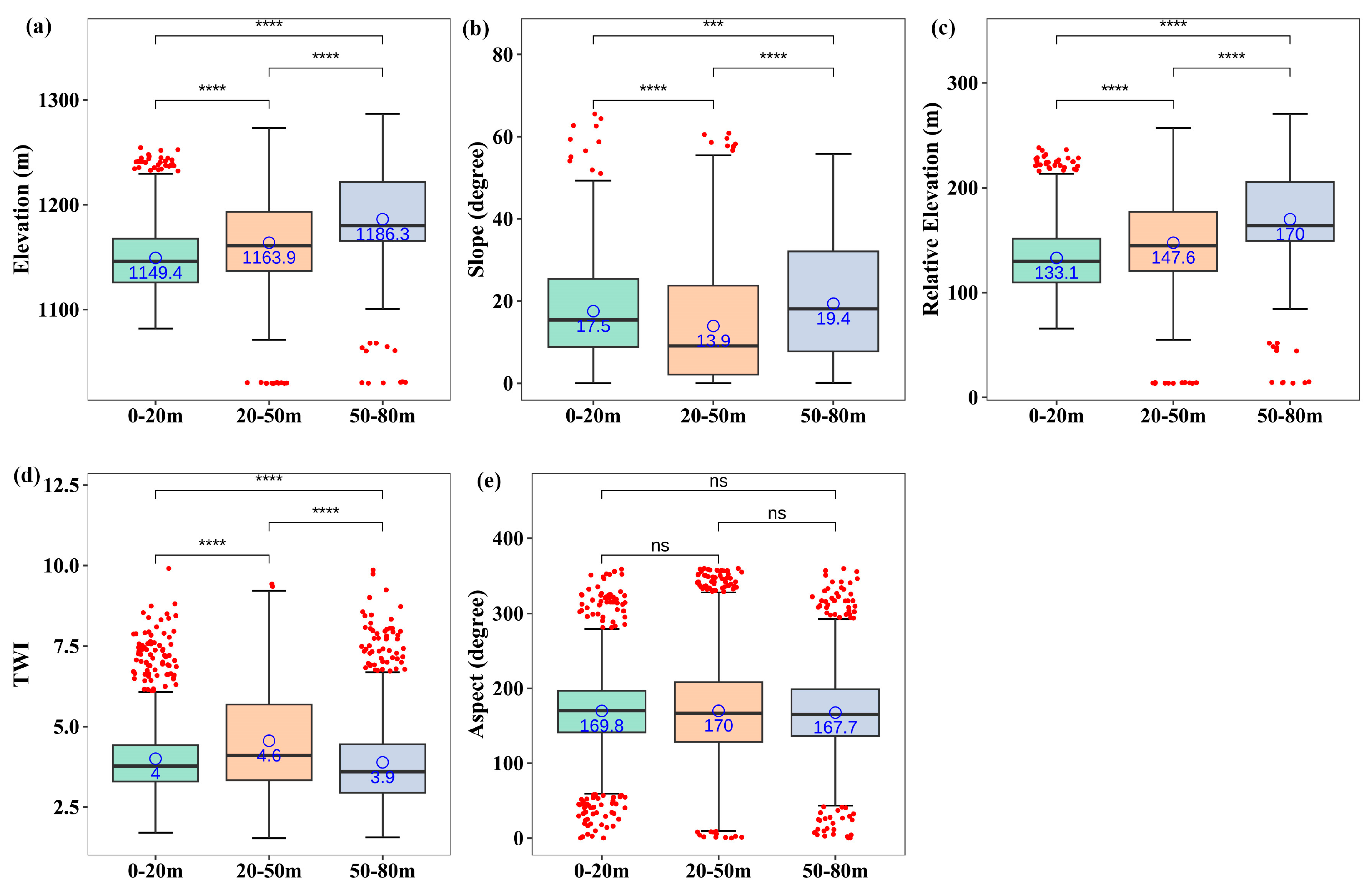
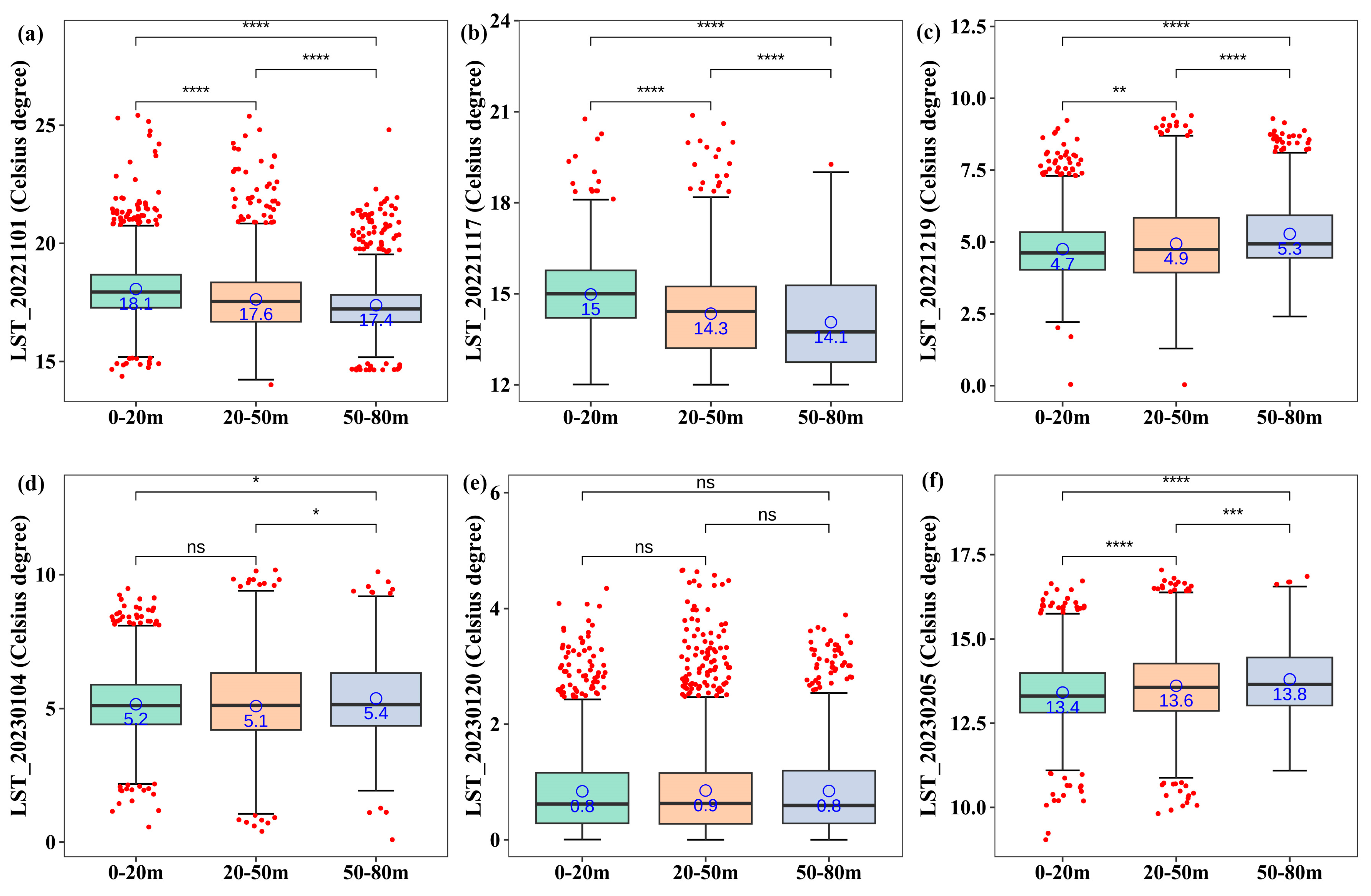
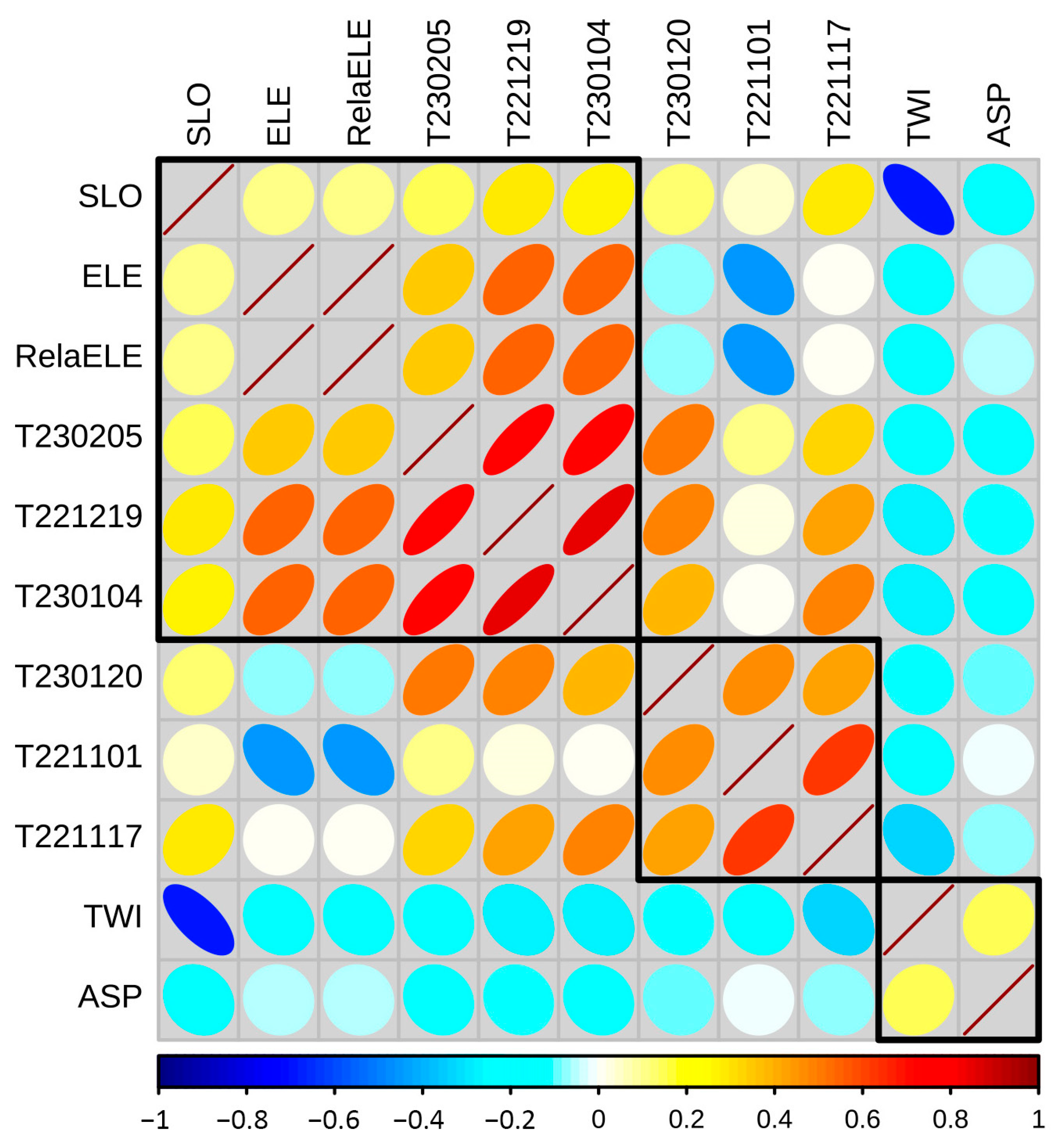
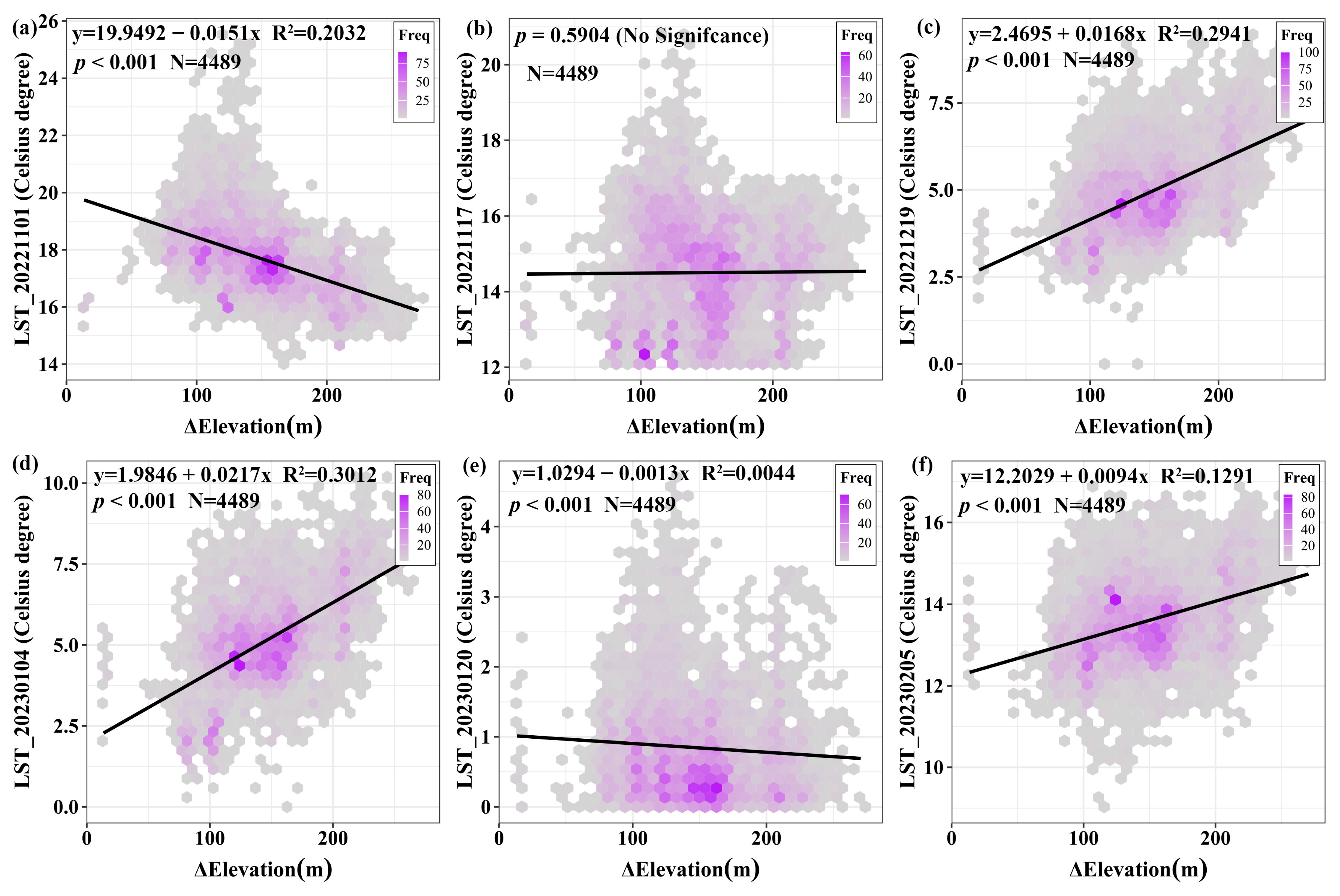
| LST Results | Date | Daily Maximum Temperature | Daily Minimum Temperature | Threshold01 Zero Temperature | Threshold02 Daily Mean Temperature | Threshold03 Temperature at 11 O’clock |
|---|---|---|---|---|---|---|
| LST20221101 | 1 November 2022 | 16 | 4 | Null | 10 | 14 |
| LST20221117 | 17 November 2022 | 14 | 1 | Null | 8 | 12 |
| LST20221219 | 19 December 2022 | 2 | −12 | 0 | −5 | 0 |
| LST20230104 | 4 January 2023 | 2 | −10 | 0 | −4 | 0 |
| LST20230120 | 20 January 2023 | −2 | −15 | 0 | −8 | −4 |
| LST20230205 | 5 February 2023 | 9 | −6 | Null | 2 | 7 |
Disclaimer/Publisher’s Note: The statements, opinions and data contained in all publications are solely those of the individual author(s) and contributor(s) and not of MDPI and/or the editor(s). MDPI and/or the editor(s) disclaim responsibility for any injury to people or property resulting from any ideas, methods, instructions or products referred to in the content. |
© 2025 by the authors. Published by MDPI on behalf of the International Society for Photogrammetry and Remote Sensing. Licensee MDPI, Basel, Switzerland. This article is an open access article distributed under the terms and conditions of the Creative Commons Attribution (CC BY) license (https://creativecommons.org/licenses/by/4.0/).
Share and Cite
Wang, Y.; Zhang, M.-S.; Yang, C.; Luo, D.; Dong, Y.; Liu, H.; Zhang, X.; Yan, Y.; Feng, L. Topography–Land Surface Temperature Coupling: A Promising Approach for the Early Identification of Coal Seam Fire Zones. ISPRS Int. J. Geo-Inf. 2025, 14, 206. https://doi.org/10.3390/ijgi14050206
Wang Y, Zhang M-S, Yang C, Luo D, Dong Y, Liu H, Zhang X, Yan Y, Feng L. Topography–Land Surface Temperature Coupling: A Promising Approach for the Early Identification of Coal Seam Fire Zones. ISPRS International Journal of Geo-Information. 2025; 14(5):206. https://doi.org/10.3390/ijgi14050206
Chicago/Turabian StyleWang, Yao, Mao-Sheng Zhang, Chuanbo Yang, Da Luo, Ying Dong, Hao Liu, Xu Zhang, Yuteng Yan, and Li Feng. 2025. "Topography–Land Surface Temperature Coupling: A Promising Approach for the Early Identification of Coal Seam Fire Zones" ISPRS International Journal of Geo-Information 14, no. 5: 206. https://doi.org/10.3390/ijgi14050206
APA StyleWang, Y., Zhang, M.-S., Yang, C., Luo, D., Dong, Y., Liu, H., Zhang, X., Yan, Y., & Feng, L. (2025). Topography–Land Surface Temperature Coupling: A Promising Approach for the Early Identification of Coal Seam Fire Zones. ISPRS International Journal of Geo-Information, 14(5), 206. https://doi.org/10.3390/ijgi14050206









